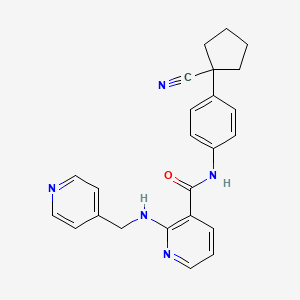Apatinib, 811803-05-1, rivoceranib, Apatinib free base, N-(4-(1-Cyanocyclopentyl)phenyl)-2-((pyridin-4-ylmethyl)amino)nicotinamide, Apatinib (free base), YN968D1, N-[4-(1-cyanocyclopentyl)phenyl]-2-(pyridin-4-ylmethylamino)pyridine-3-carboxamide, 5S371K6132, N-(4-(1-cyanocyclopentyl)phenyl)-2-(pyridin-4-ylmethylamino)nicotinamide, 3-Pyridinecarboxamide, N-(4-(1-cyanocyclopentyl)phenyl)-2-((4-pyridinylmethyl)amino)-, UNII-5S371K6132, apatinib (in China), RIVOCERANIB [INN], Rivoceranib (USAN/INN), RIVOCERANIB [USAN], RIVOCERANIB [WHO-DD], GTPL7648, SCHEMBL1814966, CHEMBL3186534, Apatinib free base; YN-968D1, DTXSID601024366, AMY21302, BCP02840, EX-A1794, HY-13342A, MFCD21648511, NSC772886, NSC799333, s5248, AKOS024464453, CCG-268625, DB14765, DS-7455, NSC-772886, NSC-799333, SB16590, N-[4-(1-Cyanocyclopentyl)phenyl]-2-[(4-pyridinylmethyl)amino]-3-pyridinecarboxamide, NCGC00249393-01, NCGC00249393-08, AC-27461, BA175030, DA-35324, CS-0003200, C76598, D11288, AB01274807-01, AB01274807_02, Q27262801, N-[4-(1-Cyanocyclopentyl)phenyl]-2-[(4-pyridinylmethyl)amino]nicotinamide, N-[4-(1-Cyanocyclopentyl)phenyl]-2-[(pyridin-4-ylmethyl)amino]pyridine-3-carboxamide



